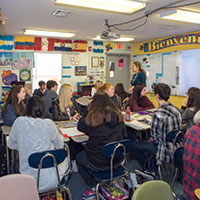 Charter schools demand remedy for unequal funding
Charter schools demand remedy for unequal funding
STORY
Ever since Indian River Charter High School was established in 1998 as the first charter high in the state, its backers have fought to remedy the lopsided disparity in funding between the county’s traditional and charter schools.
Charter schools are public schools entitled to state funding, but the Indian River County School District gives them far less money for building construction and upkeep, equipment and other expenses than it allocates to the traditional public schools.
Indian River County’s five charters – the Charter High School, North County Charter School, St. Peter’s Academy, Sebastian Charter Junior High and Imagine School – all say they are underfunded.
As a result, more kids are squeezed into portable classrooms than the cramped units were meant to accommodate, while areas such as the rotunda at the Charter High have been pressed into service as assembly and performing arts spaces and even for storage. Faculty carrying expanded workloads are under stress.
Today, with new School District leadership – Superintendent Mark Rendell was hired last year – there is some hope positive changes are coming. But key differences remain unsolved, and the charters still plan to take their grievances to the 19th Judicial Circuit Court or the State Department of Administrative Hearings in Tallahassee.
IRCHS Board Chairman Gene Waddell talked about the funding disparity at the Taxpayers Association meeting on Jan. 13.
Unlike what many believe, he said, according to Florida statute, “We are part of the public school system – all charter schools in Florida are public schools.”
As the official charter schools sponsor, the School Board has a lengthy list of specific state-mandated “duties.” The district is to provide administrative and educational services to the charter schools and “shall not charge any additional fees or surcharges.” The district must also ensure that charter students are “funded . . . the same as students enrolled in other district public schools.”
The statutes include a clear formula for funding charter school students – a formula Waddell said is not being followed.
“During the last eight years, capital outlay funding available to charter schools has plummeted, and this has had a major impact on charter schools’ ability to add new facilities, renovate old ones, pay for student transportation and for insurance,” he said.
Comparing 2015 capital funding, Waddell said, the five charter schools receive $295 per student while other schools in the district get $1,546 per student. Parity for all district students would be $1,365 per student.
Pushing back against Waddell’s presentation, District School Board member Charles Searcy said the traditional public schools have issues charter schools don’t have to deal with: unions; too much paperwork; discipline – “a major issue”; political correctness; and a teacher bonus system that is based on students delivering grades.
The School Board, he continued, is “responsible for determining what is necessary” for the schools, including the charter schools. Decisions are made by (majority vote). The system works, and it works well.”
Shortly after the Taxpayers Association meeting, Waddell and Charter High principal Cynthia Aversa provided a tour of the campus to illustrate some of the issues the charters face, including chronically crowded conditions.
A look inside the school’s portable classrooms found more students squeezed into each small unit than the temporary structures were built to accommodate. The school’s central atrium – which doubles as assembly hall and performing arts arena – was filled with construction tools, a stage and several very large set pieces.
Negotiating a path around the work, Aversa said, “we’ve had to be creative in our course offerings. We’ve had to eliminate some classes and blend some, and to diversify our faculty. We ask each teacher to take on an extra, different session. It makes for a longer day and a longer week for them.”
Despite the obvious problems, Aversa is proud of her school’s teaching staff and students for not only managing but excelling, with high test scores and graduation rates.
Teachers love the school and don’t want to leave, she said, but because the Charter High isn’t able to pay a competitive wage, they sometimes have no choice. “We’ve had good teachers look for other jobs. That can be emotional. Our goal is to (have salaries) on a par with (the other) District salaries.”
Teaching and administrative spaces are needed, along with restrooms, boys and girls locker rooms and storage space. Estimated cost for improvements on existing buildings and a new multi-purpose building would be close to $8 million.
“But this will not hold us back,” Aversa promises. “We will keep persevering.”
Although Superintendent Rendell was not available to comment for this story, his 2015-2016 goals include improving the District’s relationship with the charter schools.
“We are under new management in the School District, with a great new superintendent,” Searcy said at the Taxpayers Association meeting, suggesting that things may get better for the charter schools in the near future.
Waddell agreed the change in leadership seemed positive so far. “Dr. Rendell is very accessible and more receptive (to the charter school boards). He has assigned a member of his Senior Management Team as his Charter Liaison, which was one of our requests.”








